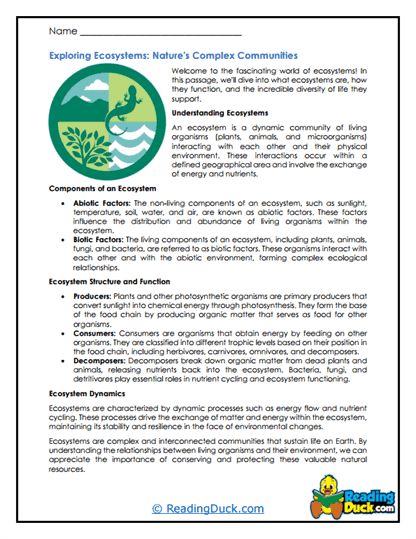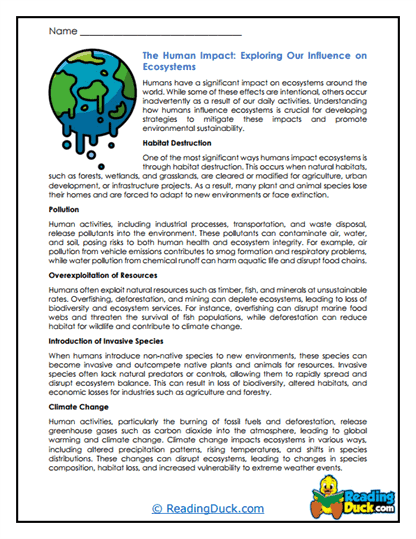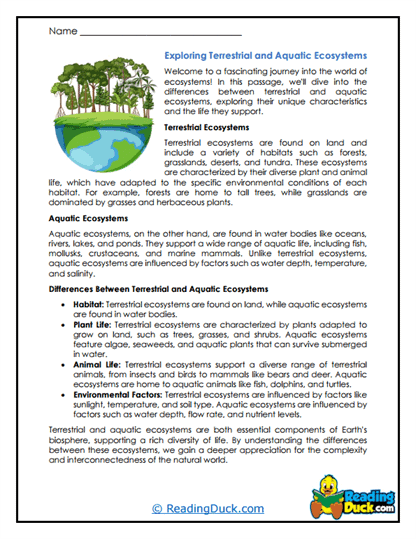Ecosystems Worksheets
About Our Ecosystems Worksheets
Our collection of Ecosystems worksheets provides an engaging and comprehensive exploration of the dynamic interactions that sustain life on Earth, making it an essential resource under the broader categories of Science: Biology and Environmental Sciences. Understanding ecosystems is crucial for grasping how organisms interact with each other and their environment, the flow of energy and nutrients, and the delicate balance required to maintain these systems. These worksheets are designed to deepen students' knowledge of ecosystems, their components, and the environmental factors that influence them.
This collection is a subtopic within Biology and Environmental Sciences and contains several worksheet sets. Each worksheet set includes:
- Multiple Choice Questions: These questions assess students' comprehension of the reading passage, ensuring they grasp the key concepts and details presented.
- Short Answer Questions: This section prompts students to write their responses, encouraging them to articulate their understanding in their own words. This exercise helps reinforce their knowledge and improves their ability to communicate scientific information effectively.
- Open-Ended Questions: These questions invite students to share their personal thoughts, opinions, and reflections on the material, fostering critical thinking and allowing them to connect more deeply with the content.
Each worksheet is accompanied by a detailed answer key, making it easy for educators and parents to review students' work. The worksheets are provided in PDF format, ensuring they can be easily viewed electronically, downloaded, and printed.
Exploring Ecosystems: The Web of Life
Ecosystems are communities of living organisms interacting with their physical environment, functioning together as a system. These interactions involve the flow of energy and the cycling of nutrients, supporting a balance that is essential for the survival of all species within the ecosystem. When introducing students to the topic of ecosystems, it’s important to emphasize the complexity and interconnectedness of these systems, as well as the role of humans in both maintaining and disrupting ecological balance.
Components of Ecosystems: An ecosystem is made up of both biotic (living) and abiotic (non-living) components:
- Biotic Components: These include all the living organisms in an ecosystem, such as plants, animals, bacteria, and fungi. Biotic components are categorized into producers, consumers, and decomposers, each playing a specific role in the ecosystem. Producers, such as plants and algae, convert sunlight into energy through photosynthesis, forming the base of the food chain. Consumers, such as herbivores, carnivores, and omnivores, obtain energy by eating other organisms. Decomposers, like fungi and bacteria, break down dead organic matter, returning nutrients to the soil.
- Abiotic Components: These are the non-living factors that influence the ecosystem, including sunlight, temperature, water, air, soil, and minerals. Abiotic factors determine the types of organisms that can live in an ecosystem and how they interact. For example, the amount of sunlight and water availability in a region will influence the types of plants that can grow, which in turn affects the animals that can inhabit the area.
Types of Ecosystems: Ecosystems vary widely depending on their geographical location, climate, and other environmental factors:
- Terrestrial Ecosystems: These are land-based ecosystems, including forests, grasslands, deserts, and tundras. Each terrestrial ecosystem has its own unique climate, soil type, and organisms. For instance, tropical rainforests are characterized by high biodiversity, warm temperatures, and high rainfall, while deserts are defined by low precipitation and specialized organisms that can survive in extreme conditions.
- Aquatic Ecosystems: These include both freshwater and marine ecosystems. Freshwater ecosystems, such as rivers, lakes, and wetlands, are home to species adapted to lower salt concentrations, while marine ecosystems, including oceans, coral reefs, and estuaries, support a vast diversity of life and play a crucial role in regulating the Earth’s climate.
- Urban Ecosystems: Human-made environments, such as cities and towns, also function as ecosystems. Urban ecosystems include a mix of natural and artificial elements, where humans, animals, plants, and microorganisms interact with built environments like buildings, roads, and parks. Understanding urban ecosystems is important for sustainable city planning and improving the quality of life for urban populations.
Energy Flow and Nutrient Cycling in Ecosystems: The movement of energy and nutrients through ecosystems is vital for maintaining the balance of life:
- Food Chains and Food Webs: Energy flows through an ecosystem in a food chain, starting with producers and moving up through various levels of consumers. Food webs are more complex and interconnected, showing the multiple feeding relationships within an ecosystem. These interactions illustrate how energy is transferred from one organism to another and how the loss or addition of a species can impact the entire ecosystem.
- Nutrient Cycles: Ecosystems rely on the recycling of nutrients like carbon, nitrogen, and water through processes known as biogeochemical cycles. These cycles ensure that essential elements are available to organisms for growth and survival. For example, the nitrogen cycle involves the conversion of nitrogen from the atmosphere into forms that plants can use, which then moves through the food chain and is eventually returned to the atmosphere by decomposers.
Ecosystem Services: Ecosystems provide a wide range of services that are essential for human survival and well-being:
- Provisioning Services: These include the production of food, fresh water, fuel, and other resources that humans rely on. Ecosystems like forests and oceans are critical sources of these resources.
- Regulating Services: Ecosystems help regulate environmental conditions, such as climate regulation, water purification, and disease control. For instance, wetlands act as natural water filters, trapping pollutants and sediments before they enter rivers and lakes.
- Cultural Services: Many ecosystems have cultural, spiritual, and recreational value. Natural landscapes and wildlife are important for tourism, outdoor recreation, and cultural heritage, contributing to human happiness and mental health.
- Supporting Services: These are the underlying processes that allow ecosystems to function, such as soil formation, photosynthesis, and nutrient cycling. These services are fundamental to the production of all other ecosystem services.
Human Impact on Ecosystems: Human activities have both positive and negative impacts on ecosystems, often leading to changes that affect their balance and sustainability:
- Habitat Destruction: Deforestation, urbanization, agriculture, and mining are major causes of habitat loss. When natural habitats are destroyed, the species that depend on them may decline or become extinct, reducing biodiversity and disrupting ecosystem functions.
- Pollution: Pollution from industrial processes, agriculture, and urban runoff can degrade ecosystems by introducing harmful substances that affect the health of organisms. For example, excess nutrients from fertilizers can lead to algal blooms in aquatic ecosystems, depleting oxygen levels and harming marine life.
- Climate Change: Global climate change is altering ecosystems around the world, affecting species distribution, migration patterns, and the timing of life cycles. Changes in temperature and precipitation are particularly impactful on sensitive ecosystems like coral reefs and polar regions.
- Conservation and Restoration: Efforts to conserve and restore ecosystems are essential for maintaining biodiversity and ecosystem services. Conservation strategies include protecting natural habitats, creating wildlife corridors, and reducing human impact through sustainable practices. Restoration projects aim to rehabilitate degraded ecosystems by replanting native species, removing invasive species, and restoring natural processes like water flow.
By exploring these aspects of ecosystems, students will gain a comprehensive understanding of the complex interactions that sustain life on Earth. These worksheets will guide students through the fundamental concepts of ecosystems, encouraging them to think critically about the balance of nature and the importance of protecting our natural world.
Creative Uses For These Worksheets
Here are four creative ideas on how teachers and parents can use these Ecosystems worksheets in school or in a homeschool setup:
- Ecosystem Model Creation: Have students create physical or digital models of different ecosystems using the information from the worksheets. They can depict various components, such as food chains, biotic and abiotic factors, and nutrient cycles. This hands-on project helps students visualize the structure and function of ecosystems.
- Ecosystem Exploration Field Trip: Organize a field trip to a local park, nature reserve, or aquatic environment. Students can use the worksheets to identify different species, observe interactions between organisms, and understand how abiotic factors influence the ecosystem. This real-world application of their learning deepens their connection to the material.
- Ecosystem Role-Playing Game: Create a role-playing game where students assume the roles of different species or elements within an ecosystem. They can use the worksheets to understand their role and interact with other "species" in a way that demonstrates energy flow, competition, and symbiosis. This interactive approach makes learning about ecosystems engaging and memorable.
- Ecosystem Health Assessment: Assign students to assess the health of an ecosystem based on a case study or real-world example. Using the worksheets, they can analyze factors such as biodiversity, pollution levels, and human impact. Students can then propose conservation or restoration strategies to improve the ecosystem’s health.
The Importance of Learning About Ecosystems
Understanding ecosystems is crucial for students because it provides a foundational knowledge of how life on Earth is interconnected and how natural systems support human life. Academically, it deepens their understanding of biology, environmental science, and the intricate relationships within nature. On a personal level, learning about ecosystems empowers students to appreciate the value of biodiversity, recognize the impact of human activities on the environment, and develop a sense of responsibility toward preserving the planet. By understanding ecosystems, students are better equipped to make informed decisions and take actions that contribute to a sustainable and healthy environment for future generations.









